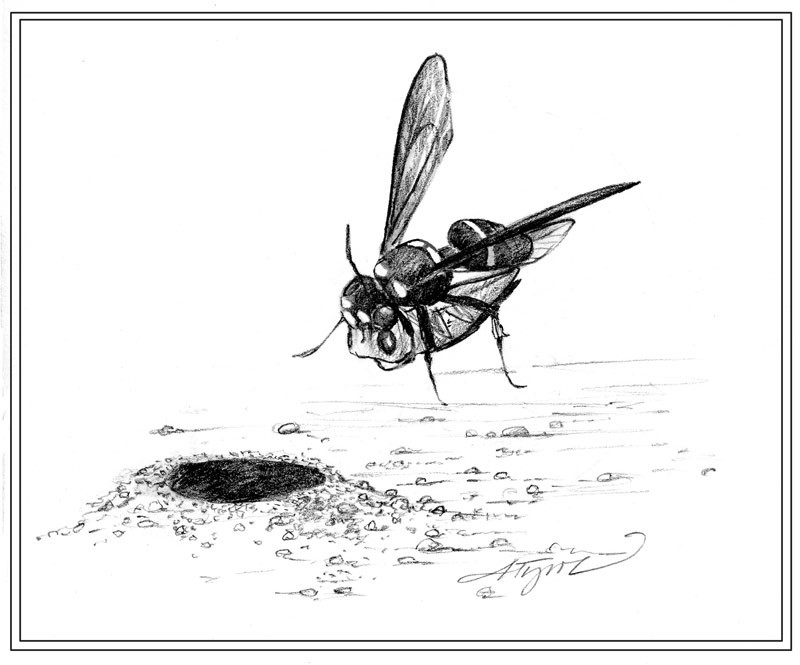
A white ash seems nearly invincible. It rises in our forests straight and sturdy, with dense wood and a hearty symmetrical crown. Ash trees become tool handles, baseball bats and, back in the day, cross-country skis. An ash is formidable and delightful to see. Yet a tiny invasive insect is now killing ashes by the millions. And our best hope for slowing the carnage may be an amiable wasp called Cerceris fumipennis.
The villain in this woodland drama is a beetle, the emerald ash borer. Shaped like a bullet, and indeed glittering like an emerald, it probably arrived in the United States hitchhiking on wood packing material carried on cargo ships or airplanes originating from its home turf in Asia. By the time the beetle was discovered here, first in Michigan in 2002, it was already too late.
The emerald ash borer has killed tens of millions of ash trees in southeastern Michigan alone. Tens of millions more have been lost elsewhere across the Midwest, New York, Pennsylvania, and now the beetles have appeared just 30 miles north of Vermont in the Province of Quebec. The adult beetle nibbles on ash leaves. But in its immature stage, its larval stage, it feeds on the inner bark and outer sapwood of an ash, impairing the tree’s ability to transport water and nutrients to leaves and roots. It’s the most effective way to kill a tree short of chopping it down. And the beetle, half an inch of terror, is now closing in on Vermont and New Hampshire. All we can do is wait … and watch.
Finding emerald ash borers is almost like searching for, well, little green bullets shot into the woods. It is an expedition of high expense and low returns. But Cerceris fumipennis, our wasp (it has no common name yet), is now being enlisted in the hunt for the beetles. It turns out that Cerceris fumipennis can catch emerald ash borers and haul them back to a waiting researcher.
Here’s how it works. Cerceris fumipennis is a ground-nesting wasp. It digs burrows for nests in clearings that have packed, sandy soils. A colony can range from just a few to several hundred of these nests. The opening to each looks as if someone jabbed a pencil into a small ant hill. Researchers and volunteers (myself included) have been finding colonies at baseball diamonds, parking areas, sand pits and open trails near woodlands.
Each nest in a colony is tended by a female Cerceris wasp. But she doesn’t just crawl in there and lay eggs. First, she flies off into the woods to search for, catch and stun members of a certain group of beetles. She will then haul the paralyzed beetle back into her burrow, stash it in one of its many underground chambers and then lay on it a single egg. The disabled beetle becomes food for the larval wasp, which emerges the following year as an adult.
Cerceris specializes in finding and catching wood-boring beetles in the family Buprestidae. We’ve got plenty of buprestid beetles in the woods of North America, one of which happens to be the emerald ash borer. Cerceris wasps are pretty good at finding the beetles, using sight and perhaps the beetles’ own chemical signals to zero in on its prey. In any event, Cerceris is way better than humans at finding the beetles. So once a researcher has located a Cerceris colony, he or she can sit back and watch the females fly in with their buprestid beetles to determine if emerald ash borers are among the haul.
Foresters and entomologists hot on the trail of emerald ash borer across the East are enlisting Cerceris fumipennis as unwitting assistants in their search for the destructive beetle. One of them is Trish Hanson, the forest entomologist at the Vermont Department of Forests, Parks and Recreation. Hanson and colleagues have been locating Cerceris colonies around Vermont this summer; similar efforts are underway in New Hampshire. These sites will become annual monitoring stations for emerald ash borer. The beetle has not yet been found in either state, but the first discovery could arise from the hard work of a Cerceris.
“They’re so efficient at finding them,” says Hanson, who pointed out that she herself, while out searching for insects, rarely encounters any Buprestidae beetles on her own. But at one Cerceris colony she found 10 different species of Buprestidae beetle.
Sometimes a Cerceris female will drop her catch near the nest where it can be picked up and identified. Other times the researchers snatch up the returning wasp in a net in order to determine which beetle species she’s carrying. Hanson has developed a certain fondness for the wasp, which sometimes is reluctant to relinquish its catch. Fortunately, it turns out, the wasp is fairly docile in a human hand. She’s never been stung. “It’s neat to hold something that looks a little like a yellow jacket,” says Hanson.
Postscript: Author and videographer Richard Walton has captured amazing video of Cerceris wasps and their Buprestidae prey at: www.rkwalton.com/wasps/cefu.html.

